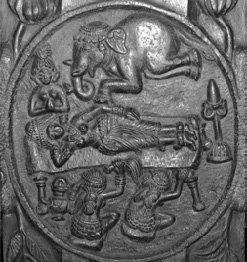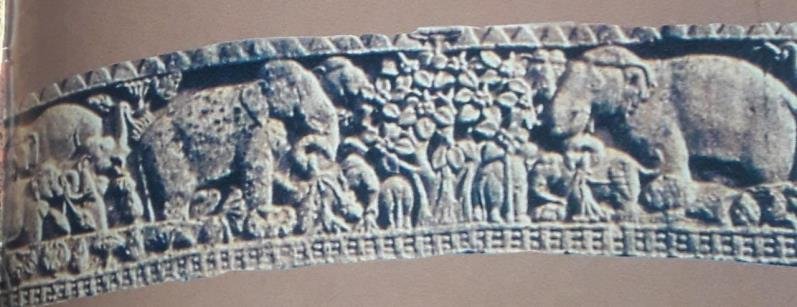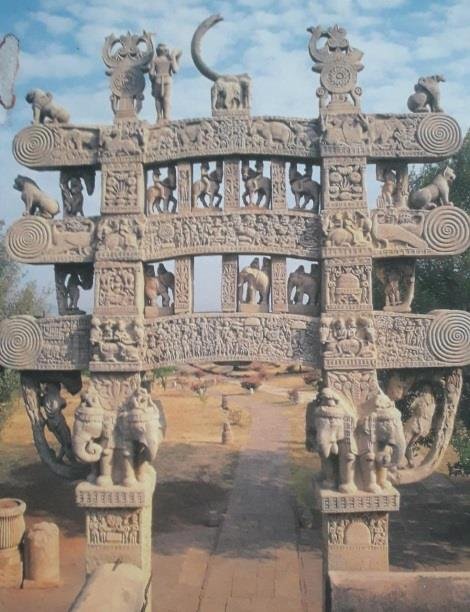Matangalila and Hastyayurveda (study)
by Chandrima Das | 2021 | 98,676 words
This page relates ‘Elephants in Buddhist mythology’ of the study on the Matangalina and Hastyayurveda in the light of available epigraphic data on elephants in ancient India. Both the Matanga-Lila (by Nilakantha) and and the Hasti-Ayurveda (by Palakapya) represent technical Sanskrit works deal with the treatment of elephants. This thesis deals with their natural abode, capturing techniques, myths and metaphors, and other text related to elephants reflected from a historical and chronological cultural framework.
Elephants in Buddhist mythology
But in Buddhist mythology elephants are highly venerated. Buddhist epigraphs, art and literature encompass a delightful repertoire of symbols and metaphors, many of them are drawn from the natural world. Animals, birds and even insects, reptiles and fish help illustrate ideas and convey fundamental concepts of the faith. In what must be one of the richest tributes paid to any animal in history, Sāriputta one of the principal disciples of the Buddha, likens the guiding spirit of Buddhism to the foot print of an elephant. The simile is explained in the Mahā-hāthipadoppama sutta (Sermon of the Great Elephant-Foot print): just as the foot-prints of all creatures may be contained within the single footprint of an elephant, so that vast canon of Buddhist theology may be encapsulated in the Four Noble Truths.[1]
In early phases of Indian sculptural art Buddha is seen represented by symbols such as a Bodhi tree, elephant, the Dhamma-cakra (Wheel of Law) and so on. Elephant as a motif serves as the vehicle of a faith and also as cognizance of Buddha. This can be seen in the Great Stūpa of Sanchi–the largest and most complete example of its kind to have remained largely intact. In fact some Prakrit inscriptions from Buddhist site at Nagarjuna-Konda refer to Buddha as musk-elephant. Although the carvings are mainly concerned with religious and mythological themes, they also provide a vibrant pictorial record of everyday life, architecture and the natural environment of Central India at that time. In these carvings, elephants show up in hundreds, fulfilling a-multiplicity of functions as symbols, structural details, mythical characters, royal mounts and so on.
According to Buddhist tradition, Mahāmāyā or Māyādevī, chief queen of Suddhadhana, the Śaka king of Kapilavastu, is believed to have dreamt one night that she was spirited away by the guardians of heaven to the mythical Anavapta Lake in the Himalayas. There, the queen was bathed and clothed in fresh robes by four celestial nymphs and ensconced in a magnificent palace. As she lay on a bed, Māyādevī was visited by a silver-white elephant bearing a silver lotus in its trunk. The elephant circled the bed thrice, struck the queen’s right side, and entered her womb. She woke up to the call of a peacock; her dream was interpreted as an auspicious omen: she had conceived a child destined for everlasting fame, either as great emperor or as a great teacher. Ten months later, Māyādevī gave birth in a grove of śāla at Lumbini, near Kapilavastu. Her child was Gautama Siddhārtha–the prince who was to become the Buddha. Thus elephant became the symbol of the birth of Buddha.

[17. Dream of Māyādevī, Bharhut]
Aśokan inscriptions bear the motif of an elephant with an inscribed word “Gajatame”[2] and many other inscriptions call him as Gaṃdha-hathisa, Gaṃdha-hadhisa etc. the sculptural depiction of the great elephant is also available at numerous places like Sanchi, Bharhut and many others. Bharhut railings with medallions depicting the dream of Māyādevī and Buddha’s birth are quite significant in this respect.
Jātaka are the narratives on the theme of Buddha’s previous births and each one narrates the act of compassion and rescue carried out by the Buddha during successive rebirth as a Bodhisattva in different forms some human and some as animals. The ultimate incarnation was that as Gautama the Bodhisattva who got liberated from the cycle of rebirth. One such Jātaka narrative depicts Buddha as a six tusked elephant named Chaddanta[3]. Here this mythical elephant is depicted as a benevolent king of an imaginary Himalayan jungle, the elephant has two wives: Cullasubaddha and Mahāsubaddha. Foraging in the jungle with his queens one day, Chaddanta accidentally bumps against a giant śāla tree in full bloom. At that moment a clump of dry leaves, twigs and red ants falls on Cullasubaddha, who stands on one side of the tree. Mahāsubaddha, on the other side, receives a casket of fragrant flowers. Cullasubaddha believes that she has been deliberately slighted. Fervently praying that she might one day be avenged. She pines away and soon dies. On account of her prayer, Cullasubaddha is reborn as a human princess and becomes chief queen of the king of Varanasi. In her new found glory, she acquires a terrible illness and declares that only the sight of the six magical tusks of a certain elephant can make her bounce back to normal health. She then instructs a hunter, Sonuttara, where this fabulous creature may be found. Disguised as a hermit, the hunter sets off on a long and difficult journey and indeed finds Chaddanta. He injures the elephant with a poisoned arrow but is unable extract the tusks. As Chaddanta lies grievously wounded, Sonuttara explains his mission. The elephant understands; he helps the hunter saw off the tusks and lies bleeding to death. Sonuttara returns with the trophies but the queen is devastated. It is too late for repentance or prayers; she instantly drops dead of guilt.
The Chaddanta Jātaka occupies a prominent position in the Sanchi monuments. The repetitive use of this narrative not only reflects its popularity but indicates its socio-religious and cultural relevance[4]. Besides the Chaddanta narrative there are other depictions bearing figures of elephants which adorn the gateway for example elephants in procession, elephants anointing Lakṣmī i.e. the Gaja-Lakṣmī motif, and so on.

[18. Sculpture of Chaddanta Jātaka, on the upper balustrade of Northern gate of Sanchi stūpa, Madhya Pradesh. Courtesy: Archaeological Survey of India]

[19. Northern gateway of Sanchi stūpa. Courtesy: Archaeological Survey of India]
Spreading of Mahāyāna Buddhism in early centuries of Christian era encourages the development of various vihāras and temples in vast areas of the sub-continent. Many of these places were situated in remote areas and undoubtedly troubled with considerable risk. To protect and give security, against evil elements and physical dangers of the path, to monks as well as lay devotees, gentle Padmapāṇi also known as Avalokiteśvara has been praised. Many sculptural representation of Padmapāṇi at the rock-cut caves of Ajanta, Aurangabad and Ellora can be seen. In large scale panel in Aurangabad, the central figure of Avalokiteśvara/ Padmapāṇi is held between eight smaller scenes in which Padmapāṇi has been shown rescuing his devotees from various torments. Despite the special status of elephant in Buddhism, one of the perceived dangers comes in the form of a wild elephant which is depicted in the panel[5].
Footnotes and references:
[1]:
V. Ram. Elephant Kingdom–Sculptures from Indian Architecture, p.29.
[2]:
See the picture no. 2 in Chapter 2.
[3]:
Jātaka, No. 514, Chaddanta Jātaka.
[4]:
Vikramajit Ram draws our attention to the fact that the story recurs twice in the architraves of two of the four gateways. In the north gateway, the pivotal forest scene fills the inner face of the upper most architrave. The imagery is idyllic with little to suggest that trouble, in fact, is brewing under the tree.
[5]:
V. Ram. Elephant Kingdom–Sculptures from Indian Architecture, p. 34.
